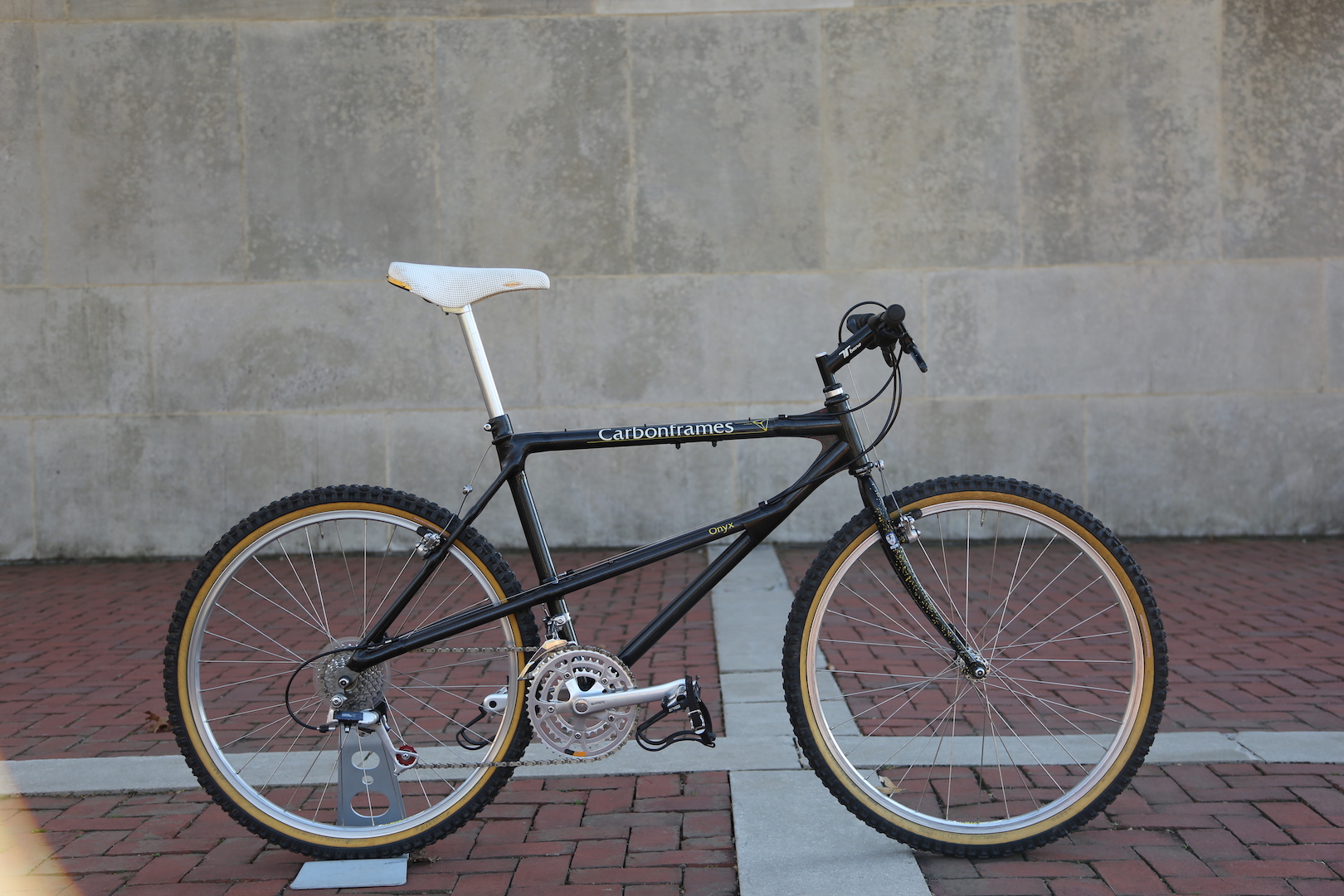Be Kind Rewind: Carbonframes Onyx
Originally posted on December 5, 2019 at 0:20 am by Martin KozaczekWalking the expo at this spring’s Dirt Fest Pennsylvania, I couldn’t help but marvel at all the killer new bikes on display. As a fan of vintage bikes, a vast majority of my experience with frame construction materials is constrained to steel, aluminum and titanium. Carbon fiber, at least as we know it today, was not widespread in the early days of mountain biking. Early attempts at composite bikes started coming on the scene with models like the 1987 Kestrel MXZ and the 1988 Trimble Carbon Cross. Those bikes were considered composite construction and, unlike today’s true carbon-fiber bikes, had fiberglass and other materials incorporated into the carbon weave, which was often applied over a core — foam for the MXZ and Douglas fir (yes, that’s a tree) for the prototype Trimble.
These early attempts at building a composite mountain bike were novel and unique, but weren’t actually carbon fiber, at least as we know it now. While it’s hard to pinpoint with total certainty the first time all-carbon construction was applied to mountain bikes, this Carbonframes Onyx is certainly a strong contender for that title. Carbonframes was the first commercial venture of Craig Calfee, who went on to start Calfee Design, a bike company well-known for their organic-looking carbon-and-bamboo bikes. While not his first carbon bike — that honor goes to the Sapphire road bike — the Onyx was his first and only attempt at building a carbon mountain bike. (Calfee now makes off-road carbon tandems.) The Onyx is one of the more striking bikes I’ve ever seen. I think it would look equally at home in a modern art gallery or as a prop designed by H.R. Giger for the set of “Alien.” The mix of the organic curves of the frame and the way the carbon tubes are bonded together is contrasted by the sharp corners of the reinforcing gussets, making you think it was designed not by an engineer, but rather by an artist.

Turns out this isn’t far from the truth. Craig Calfee gained most of his practical knowledge of carbon fiber while working on Olympic-caliber composite sculling boats, and eventually sailing boats, while pursuing a sculpting degree at the Pratt Institute in New York City. Calfee combined those skills with his passion for cycling and started building all-carbon bikes around 1988. The Onyx was a revolutionary bike at its time, and seeing it debut at the 1990 Interbike trade show in Anaheim, California, must have been breathtaking. Not only was the frame made of carbon fiber and weighed around 3.4 pounds without a fork (at a time when most frames were over 4 pounds), but it also seamlessly incorporated elevated-chainstay technology (I use that term loosely here), which was the new “it” trend in the late ’80s. The beauty of carbon fiber is that it’s isotropic and allows you to create structures with physical characteristics that depend on the direction in which it’s laid up.

Calfee understood this very well and set out to build a frame that was rigid yet had built-in damping characteristics. I think that if you compare it to the frames of the time, you would agree he succeeded; I also imagine it helped to be a spindly XC racer. However, with the benefit of 30 years of hindsight, and for a guy who tops 200 pounds, the bike is not what you’d call confidence-inspiring. The Onyx is a fine bike for an average XC jaunt on your local trails. It’s a fair climber and handles pretty well (courtesy of the short wheelbase). However, it’s a different story when you point it downhill and toss in some obstacles: Things go a bit sideways quickly. Basically, if you watch your speed and keep things in check, you’ll be fine, but my alarm bells were ringing any time speed crept up into the double digits.

While it wasn’t the best bike in the long run, it was a true milestone in the development of today’s carbon bikes. As I gear up for the larger story that will go up on dirtragmag.com, the thing that rings true for me about carbon is that, in terms of mountain bikes, it was a technology without a real application. That is, until full suspension came along. Bikes like the Onyx, Trimble, MXZ and the famous Yeti C-26 were early explorations into a world of what could be and what would eventually enable the radical machines many of us take for granted today.